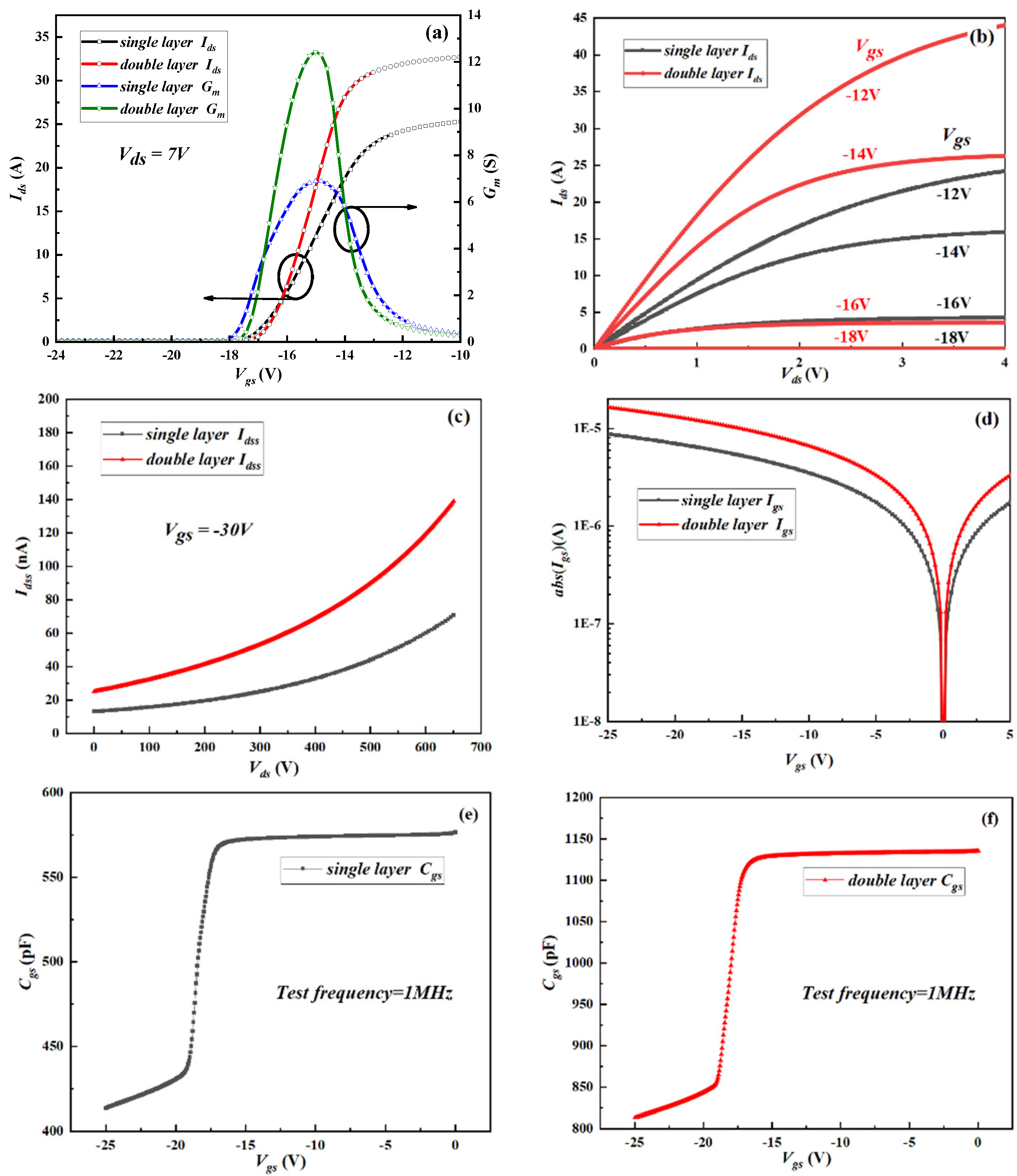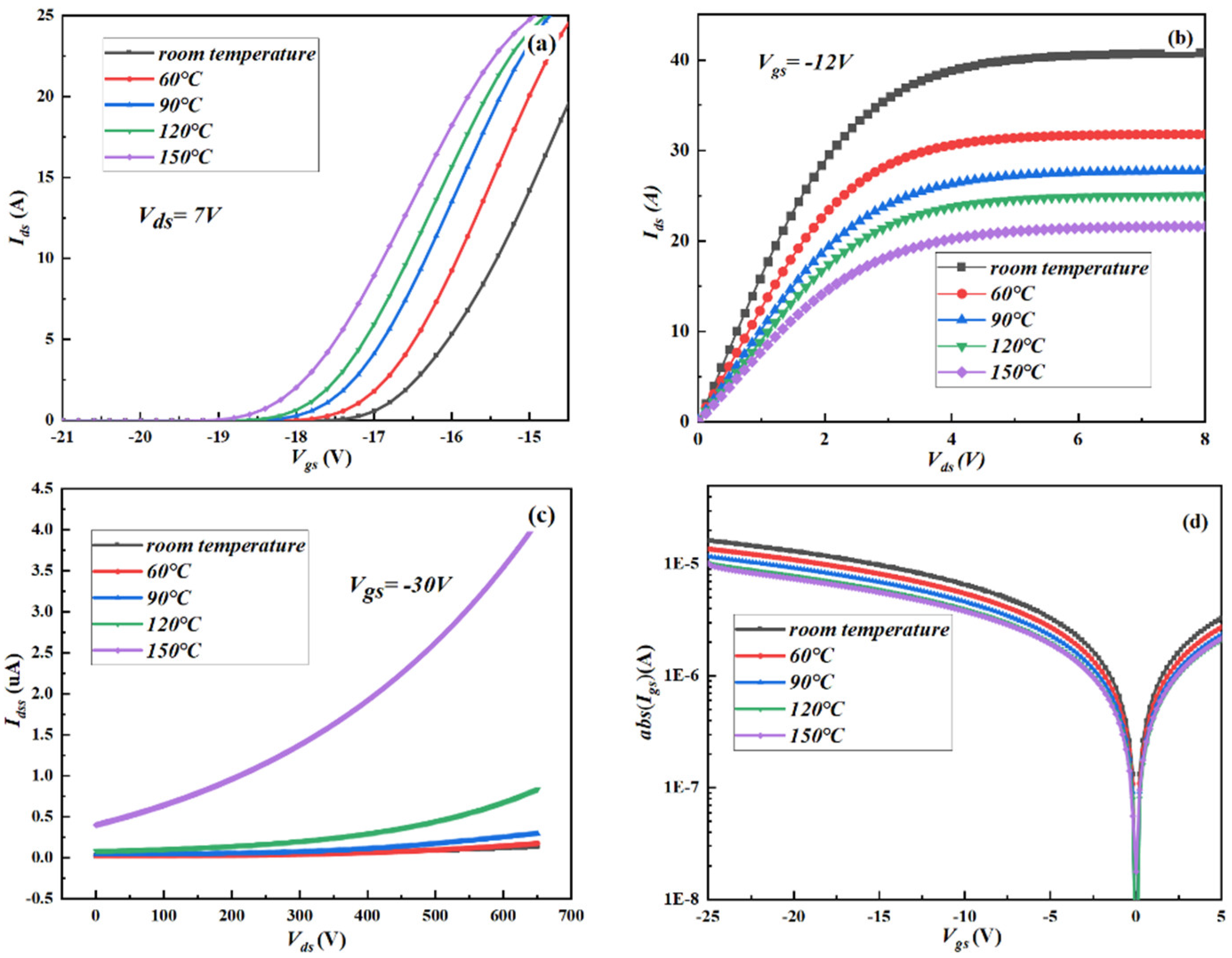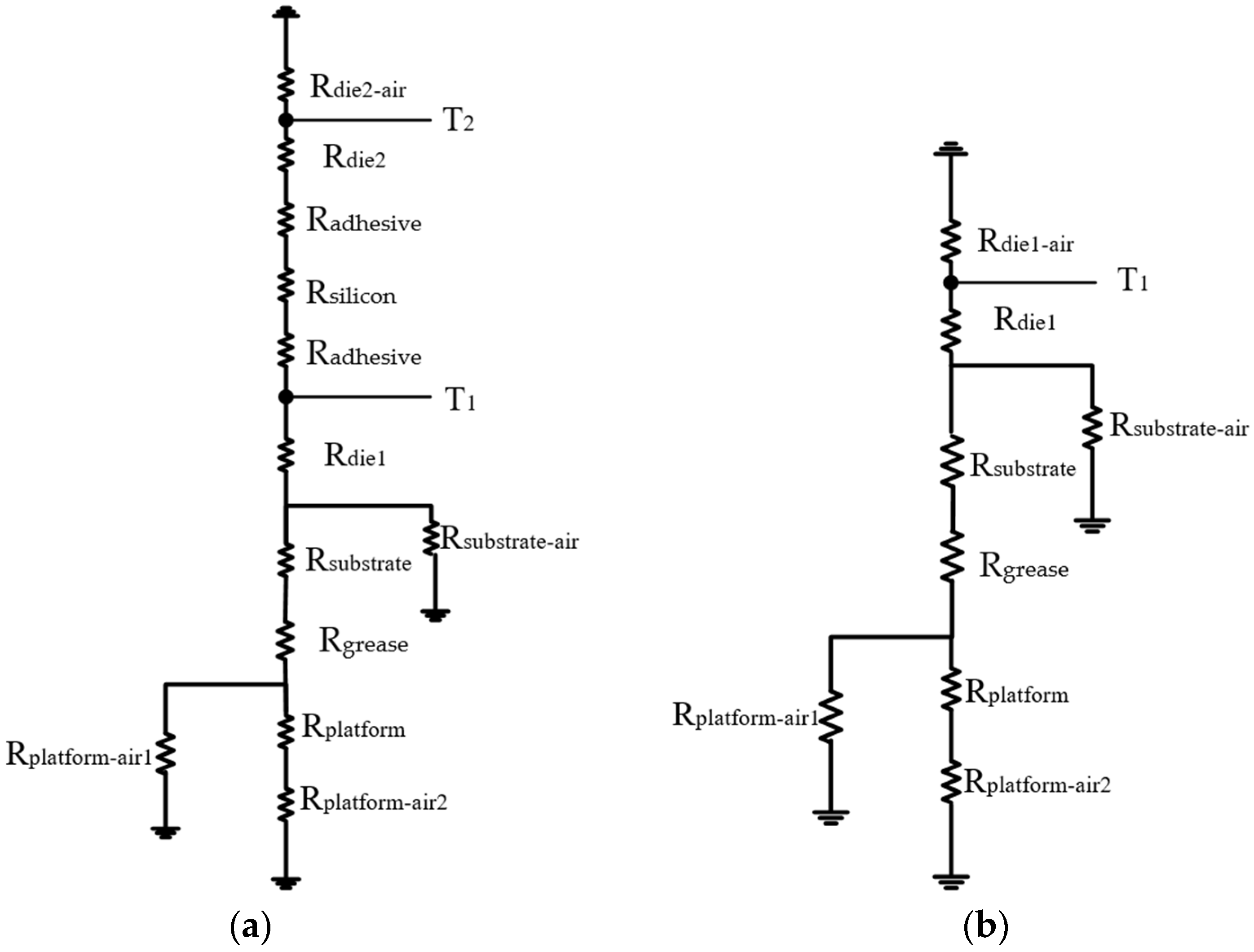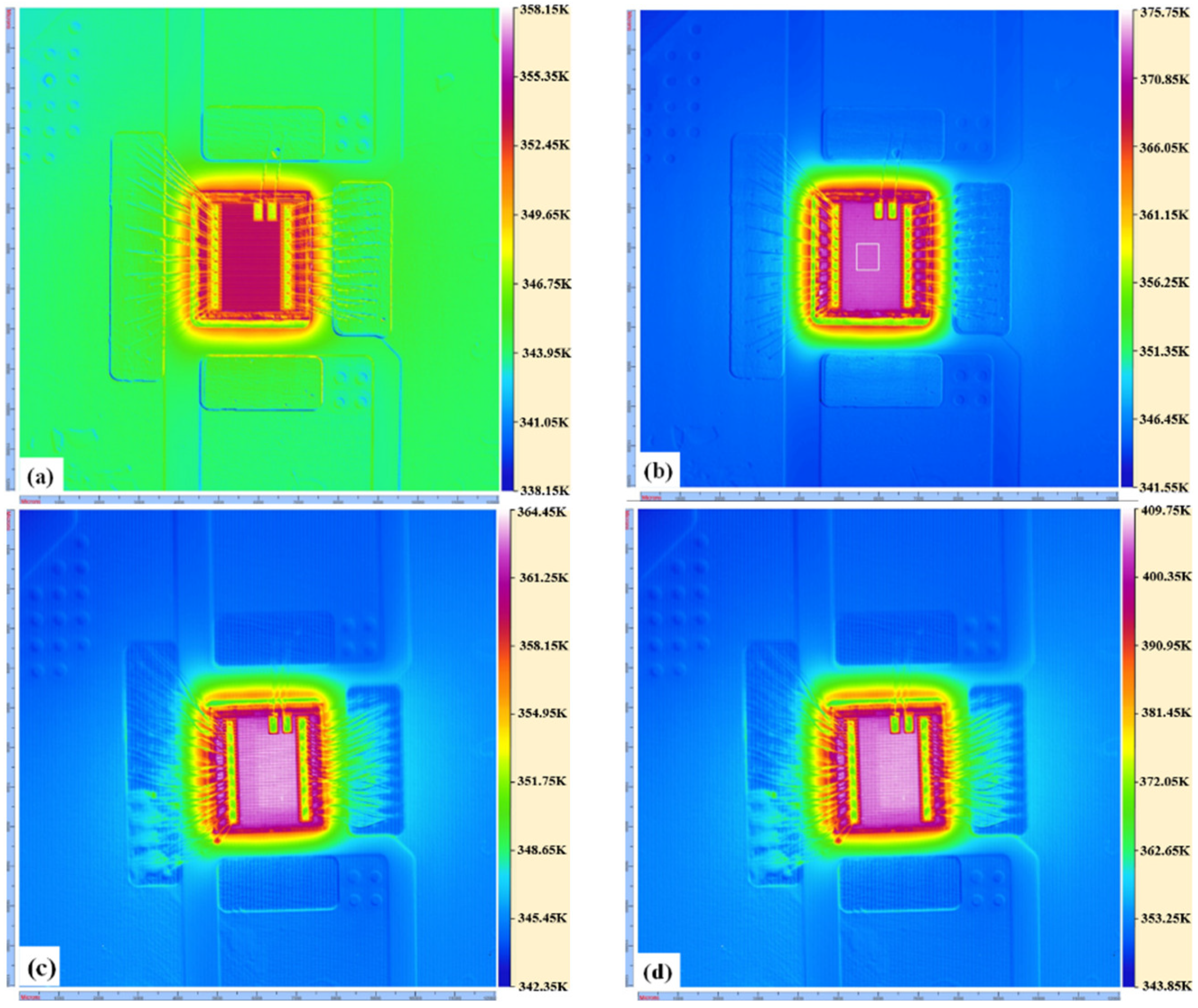The Electrical and Thermal Characteristics of Stacked GaN MISHEMT
Abstract
:1. Introduction
2. Structure and Experiment
3. Results and Discussion
- A.
- The electrical characteristics of the double-layer GaN MISHEMT
- B.
- The thermal characteristics of the double-layer GaN MISHEMT
4. Conclusions
Author Contributions
Funding
Data Availability Statement
Conflicts of Interest
References
- Chen, K.J.; Haberlen, O.; Lidow, A.; Tsai, C.L.; Ueda, T.; Uemoto, Y.; Wu, Y. GaN-on-Si Power Technology: Devices and Applications. IEEE Trans. Electron Devices 2017, 64, 779–795. [Google Scholar] [CrossRef]
- Chen, W.; Wong, K.-Y.; Chen, K.J. Single-Chip Boost Converter Using Monolithically Integrated AlGaN/GaN Lateral Field-Effect Rectifier and Normally Off HEMT. IEEE Electron Device Lett. 2009, 30, 430–432. [Google Scholar] [CrossRef]
- Yang, S.; Tang, Z.; Wong, K.-Y.; Lin, Y.-S.; Liu, C.; Lu, Y.; Huang, S.; Chen, K.J. High-Quality Interface in Al2O3/GaN/AlGaN/GaN MIS Structures with In Situ Pre-Gate Plasma Nitridation. IEEE Electron Device Lett. 2013, 34, 1497–1499. [Google Scholar] [CrossRef]
- Yang, S.; Huang, S.; Schnee, M.; Zhao, Q.-T.; Schubert, J.; Chen, K.J. Fabrication and Characterization of Enhancement-Mode High-k LaLuO3-AlGaN/GaN MIS-HEMTs. IEEE Trans. Electron Devices 2013, 60, 3040–3046. [Google Scholar] [CrossRef]
- Shi, Y.; Huang, S.; Bao, Q.; Wang, X.; Wei, K.; Jiang, H.; Li, J.; Zhao, C.; Li, S.; Zhou, Y.; et al. Normally OFF GaN-on-Si MIS-HEMTs Fabricated With LPCVD-SiNx Passivation and High-Temperature Gate Recess. IEEE Trans. Electron Devices 2016, 63, 614–619. [Google Scholar] [CrossRef]
- Chen, T.; Zhou, Q.; Wei, D.; Dong, C.; Chen, W.; Zhang, B. Physics-Based 2-D Analytical Model for Field-Plate Engineering of AlGaN/GaN Power HFET. IEEE Trans. Electron Devices 2018, 66, 116–125. [Google Scholar] [CrossRef]
- Rosker, M.J.; Albrecht, J.D.; Cohent, E.; Hodiak, J.; Chang, T.-H. DARPA’s GaN technology thrust. In Proceedings of the 2010 IEEE MTT-S International Microwave Symposium, Anaheim, CA, USA, 23–28 May 2010; pp. 1214–1217. [Google Scholar]
- Khan, M.A.; Bhattarai, A.; Kuznia, J.N.; Olson, D.T. High electron mobility transistor based on a GaN/AlxGa1-xN heterojunction. Appl. Phys. Lett. 1993, 63, 1214–1215. [Google Scholar] [CrossRef]
- Cai, Y.; Zhou, Y.; Chen, K.J.; Lau, K.M. High-performance enhancement-mode AlGaN/GaN HEMTs using fluoride-based plasma treatment. IEEE Electron Device Lett. 2005, 26, 435–437. [Google Scholar]
- Eslampour, H.; Lee, S.; Park, S.; Lee, T.; Yoon, I.; Kim, Y. Comparison of advanced PoP package configurations. In Proceedings of the 2010 Proceedings 60th Electronic Components and Technology Conference (ECTC), Las Vegas, NV, USA, 1–4 June 2010; pp. 1946–1950. [Google Scholar] [CrossRef]
- Ellison, G.N. Extensions of a closed form method for substrate thermal analyzers to include thermal resistances from source-to-substrate and source-to-ambient. In Proceedings of the Seventh 1991 Annual IEEE Semiconductor Thermal Measurement and Management Symposium, Phoenix, AZ, USA, 12–14 February 1991. [Google Scholar]
- Divay, A.; Latry, O.; Duperrier, C.; Temcamani, F. Ageing of GaN HEMT devices: Which degradation indicators? J. Semicond. 2016, 37, 38–41. [Google Scholar] [CrossRef]
- Li, S.; He, Z.; Gao, R.; Chen, Y.; Liu, Y.; Zhu, Z. Time-dependent characteristics and physical mechanisms of AlGaN/GaN metal–insulator–semiconductor high electron mobility transistors under different bias conditions. J. Phys. D Appl. Phys. 2019, 52, 485106. [Google Scholar] [CrossRef]
- Mitrofanov, O. Mechanisms of gate lag in Ga N/AlGaN/GaN high electron mobility transistors. Superlattices Microstruct. 2003, 34, 33–53. [Google Scholar] [CrossRef]
- Danesin, F.; Tazzoli, A.; Zanon, F.; Meneghesso, G.; Zanoni, E.; Cetronio, A.; Lanzieri, C.; Avanga, S.; Peroni, M.; Romanini, P. Thermal storage effects on AlGaN/GaN HEMT. Microelectron. Reliab. 2008, 48, 1361–1365. [Google Scholar] [CrossRef]
- Zheng, C.; Lv, J.; Zhou, S.; Liu, S. Effect of reverse leakage current on the reliability of InGaN/GaN high power LEDs. In Proceedings of the 2016 17th International Conference on Electronic Packaging Technology (ICEPT), Wuhan, China, 16–19 August 2016; pp. 824–827. [Google Scholar] [CrossRef]
- Monier-Vinard, E.; Bissuel, V.; Dia, C.; Daniel, O. Delphi style compact modeling by means of genetic algorithms of system in Package devices using composite sub-compact thermal models dedicated to model order reduction. In Proceedings of the 13th InterSociety Conference on Thermal and Thermomechanical Phenomena in Electronic Systems, San Diego, CA, USA, 30 May–1 June 2012; pp. 1170–1178. [Google Scholar]
- Jinyuan, Z.; Bin, Z.; Guoyuan, L. Study on predicting the temperature of stacked chip based on thermal resistance matrix. In Proceedings of the 2017 IEEE 24th International Symposium on the Physical and Failure Analysis of Integrated Circuits (IPFA), Chengdu, China, 4–7 July 2017; pp. 1–5. [Google Scholar] [CrossRef]
- Garcia, E.A. Compact modeling approaches to multiple die stacked chip scale packages [thermal modeling]. In Proceedings of the Ninteenth Annual IEEE Semiconductor Thermal Measurement and Management Symposium, San Jose, CA, USA, 11–13 March 2003. [Google Scholar] [CrossRef]
- Joiner, B.; Adams, V. Measurement and Simulation of Junction to Board Thermal Resistance and Its Application in Thermal Modeling. In Proceedings of the Fifteenth Annual IEEE Semiconductor Thermal Measurement and Management Symposium, San Diego, CA, USA, 9–11 March 1999; pp. 22–26. [Google Scholar]
- Garcia, E.; Chiu, C.-P. Two-resistor compact modeling for multiple die and multi-chip packages. In Proceedings of the Semiconductor Thermal Measurement and Management IEEE Twenty First Annual IEEE Symposium, San Jose, CA, USA, 15–17 March 2005. [Google Scholar] [CrossRef]







| Thermal Resistance | Calculated Value [°C/W] | Thermal Resistance | Calculated Value [°C/W] |
|---|---|---|---|
| Rdie−air | 10,775.86 | Rdie1 = Rdie2 | 0.25 |
| Rsubstrate | 111.11 | Rsubstrate−air | 162.41 |
| Rplatform | 0.05 | Rplatform−air1 | 7.26 |
| Rplatform−air2 | 6.94 | Rsilicon | 1.90 |
| Radhesive | 10.78 | Rthermal grease | 0.03 |
| Test Devices | Input Current (A) | Dissipation Power (W) | Measured Temperature (K) | Calculated Temperature (K) | Relative Error (%) |
|---|---|---|---|---|---|
| single-layer MISHEMT | 1.115 | 0.155 | 354.75 | 353.50 | 0.35 |
| 1.746 | 0.455 | 373.85 | 373.54 | 0.08 | |
| double-layer MISHEMT | 2.223 | 0.320 | 364.45 | 372.08 | 2.09 |
| 3.445 | 0.938 | 409.05 | 427.95 | 4.62 |
Publisher’s Note: MDPI stays neutral with regard to jurisdictional claims in published maps and institutional affiliations. |
© 2022 by the authors. Licensee MDPI, Basel, Switzerland. This article is an open access article distributed under the terms and conditions of the Creative Commons Attribution (CC BY) license (https://creativecommons.org/licenses/by/4.0/).
Share and Cite
Hui, C.; Chen, Q.; Shi, Y.; He, Z.; Huang, Y.; Lu, X.; Wang, H.; Jiang, J.; Lu, G. The Electrical and Thermal Characteristics of Stacked GaN MISHEMT. Micromachines 2022, 13, 2101. https://doi.org/10.3390/mi13122101
Hui C, Chen Q, Shi Y, He Z, Huang Y, Lu X, Wang H, Jiang J, Lu G. The Electrical and Thermal Characteristics of Stacked GaN MISHEMT. Micromachines. 2022; 13(12):2101. https://doi.org/10.3390/mi13122101
Chicago/Turabian StyleHui, Caixin, Qiuqi Chen, Yijun Shi, Zhiyuan He, Yun Huang, Xiangjun Lu, Hongyue Wang, Jie Jiang, and Guoguang Lu. 2022. "The Electrical and Thermal Characteristics of Stacked GaN MISHEMT" Micromachines 13, no. 12: 2101. https://doi.org/10.3390/mi13122101
APA StyleHui, C., Chen, Q., Shi, Y., He, Z., Huang, Y., Lu, X., Wang, H., Jiang, J., & Lu, G. (2022). The Electrical and Thermal Characteristics of Stacked GaN MISHEMT. Micromachines, 13(12), 2101. https://doi.org/10.3390/mi13122101






